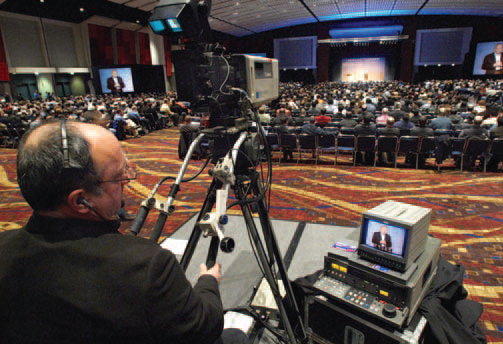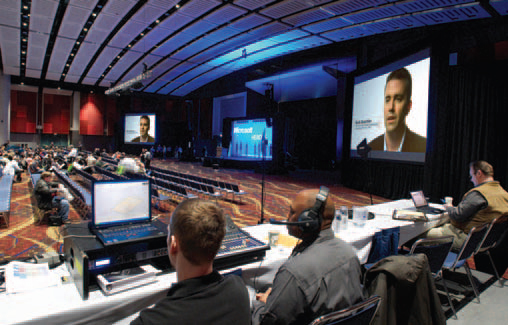By Wendy L. Ellis
FOR MICROSOFT'S "HEROES HAPPEN HERE" TOUR, AV CREATIVITY AND FLEXIBILITY PUT SOME "SIZZLE" IN THE SHOW.
Technicians from CAVCOMM run the show from a production station at the house mix position
Longhorn, Katmai, and Orcas are ordinary Tom, Dick, and Harry. Like a rock band, this trio of new 2008 Microsoft server software has been playing to capacity crowds in a national launch tour that swept 60 cities in just three months. With its theme of "Heroes Happen Here," Microsoft reached out to the unsung heroes of the IT world: the software developers, IT professionals, and channel partners who have all the know-how and none of the spotlight.
"These are the people that get in up to their elbows and actually make these products work," says Michael Canfield, president of CAVCOMM Corporation of Skokie, IL, which took on the audio visual challenges of this whirlwind tour. "Microsoft has a very traditional dealer network that they support heavily with regionalized business meetings on a regular basis." But these were no ordinary business meetings. Charged with the task of introducing the new software - Longhorn, the Windows Server 2008 operating system, Katmai, a.k.a. Microsoft SQL Server 2008, and Orcas, Microsoft Visual Studio 2008 - the Microsoft America Team in Dallas, TX, and CAVCOMM knew this tour would have to go far beyond the usual fare.
THE "WOW" FACTOR
According to NeKeta Argrow, logistics manager for Microsoft Across America, an important goal of the tour was to provide a professional, flawless audio visual display that would show the new Microsoft products to their best advantage, without overshadowing the software itself. "You want to do events that will support the technology or solution you're trying to deliver to customers and partners as it's a marketing vehicle," she says. Equally important was giving the audience a memorable experience.
In the 12 largest cities, including New York, Chicago, and Seattle, the day-long event began with a 75-minute keynote presentation, then broke the audience into three breakout rooms for six more hours of software demonstrations.
"At the last minute we didn't really have a scenic look for the tour that I was happy with," says Canfield. He felt they needed something that would start the program on a high note and hold it together throughout the day.
Canfield came up with the idea of cutting life-size silhouettes from corrugated plastic (lifting them from the graphic used as the Heroes Happen Here logo), placing them at theback of the keynote stage behind a scrim and then back lighting them with LED fixtures. "We used LED lighting because it's compact and energy efficient, and it gives us a palette of colors to make things interesting," he says. "We'd do a quick dip of the lighting, insert the person acting as emcee between the silhouettes, and she would walk out of the silhouettes with the Heroes Happen Here music playing along. It was a lot of fun and very inexpensive."
"It definitely brought a layer of excitement to the event," says Argrow. "Even in the smallest of events you want to break that monotony of watching PowerPoints and listening to speakers all day."
Though the keynote started the day on an impressive note, it was the breakout sessions that showed the developers the nuts and bolts of the new software and the advantages it could bring their clients. The breakout sessions were designed specifically for the target audience for that particular product. There were sessions for developers, technology decision makers, database administrators, IT professionals, and Microsoft Partners. In addition, the tour included an exhibit area and a hands-on lab where customers and Microsoft Partners could try the newly released software for themselves. In the 48 smaller cities, the program was identical but without the initial keynote experience and hands-on labs. Instead, each room began with a 15-minute video produced by Microsoft, extolling the talents of their target audience.
SITE UNSEEN
CAVCOMM maintained program continuity, even though every new venue offered its own set of unique logistics.
"The things that successful business-to-business tours most need are flexibility, inventiveness, and creativity," says Canfield. "With a tour the size of Heroes Happen Here, it would be a daunting challenge and very expensive to do a physical site survey of every venue." Instead, CAVCOMM relied on information and drawings from the hotels and convention centers, and they were always prepared for last-minute changes. "You walk in and your 14-foot ceilings can all of a sudden turn out to be 9-foot ceilings," says Canfield. "Well, your 9 x 12 screen isn't going to work, but you still have to present a good image for your client." Canfield says their trucks typically carried a variety of extra equipment just for those occasions.

A camera operator uses a 3-chip Canon studio camera to provide close-up images of the presenters on each of the four screens.
TECHNOLOGY-ENHANCED LEARNING APPLICATIONS ARE BECOMING MORE DEMANDING OF INFRASTRUCTURE OVER TIME, NOT LESS.
To make each event happen, CAVCOMM crews would arrive the day before, then begin a setup and rehearsal process that took as long as 12 hours for the larger events.
They started by setting up a stage in the keynote area with an 8- to 12-cabinet Meyer Sound line array on each side and two 15- by 20- foot rear projection screens, each taking its image from a 20,000-lumen Christie Digital projector. Two more rear projection screens, this time 7.5 feet by 10 feet with 5,000-lumen projectors, were hung from the ceiling about 100 feet from the stage, to maintain proper viewing standards.
Centered at the back of the room, technicians positioned a three-chip Canon studio camera and a wireless receiver for a handheld ENG camera to provide close-up images of the presenters on each of the four screens. These cameras were particularly important in the larger venues, where people in the back would otherwise have trouble seeing the presenters, and in those cities where Microsoft had to open up a second room for overflow audiences.
CAVCOMM techs also established and manned a production station at the house mix position with a Yamaha LS-9 Digital mixing console, PixelRange stage lighting controls, DVD players for pre-show videos, and a laptop they used to configure the line arrays for each venue. Presenters wore Shure UHF-R wireless microphones.
The technicians also set up AV systems in the breakout rooms that included 5,500-lumen Sanyo PLC-XP57 projectors, Mackie SRM-450 powered speakers, UHF-R wireless microphones, and a smaller console with DSP that they used to mix the microphones and tune the sound.
EXECUTION EXCELLENCE
Still, it's not the AV that's the challenge in a multi-city tour, but the project management. "Very few staging companies would touch something like this," says Canfield. "The pressure to get every detail right can be intense." Even the weather plays a role. Like the U.S. Mail, CAVCOMM trucks routinely deal with blizzards, storms, blackouts, and floods just to get to their destination. With their trucks almost constantly on the road from early June to mid-March, project managers are constantly looking for the safest, most economical routes. "Getting through the mountain passes from California to Seattle was a real challenge this year," adds Canfield. "You always have to have a backup plan - you always have to be prepared in case a truck can't get through."
Although budget was a key consideration, says Agrow, "From a logistics perspective, we wanted to make sure all the events were executed flawlessly."
For the Heroes Happen Here tour, CAVCOMM's Microsoft account manager, Scott Gilbert, estimates the larger keynote events ran around $50,000 for AV while the smaller events averaged around $20,000. "In the past we've done events in breakout rooms with up to 1,000 people," says Gilbert. "But once you go beyond 1,200 or 1,500 people in a room what you have to provide to get your message across changes dramatically. All of a sudden you need a different audio technology. The 9x12 screens become 15x20, and that means the projectors have to be incredibly bright. It's not a linear cost increase. It's exponential."
INFO
CANONwww.canon.com
CAVCOMMwww.cavcommcorp.com
CHRISTIE DIGITALwww.christiedigital.com
MACKIEwww.mackie.com
MEYER SOUNDwww.meyersound.com
MICROSOFTwww.microsoft.com
SANYOwww.sanyo.com
SHUREwww.shure.com
YAMAHA COMMERCIALwww.yamaha.com
Wendy Ellis is a freelance writer with extensive experience in the AV and broadcast industries. She can be reached atwww.kreski.com/contact.html.
